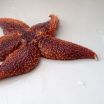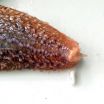Starfish have a surprising talent for squeezing foreign bodies out through the skin
2015-06-16
(Press-News.org) Starfish have strange talents. Two biology students from University of Southern Denmark have revealed that starfish are able to squeeze foreign bodies along the length of their body cavities and out through their arm tips. This newly discovered talent gives insight into how certain animals are able to quickly heal themselves.
The two biology students, Frederik Ekholm Gaardsted Christensen and Trine Bottos Olsen have discovered a starfish behaviour that has never previously been described in the scientific literature. As part of their studies they were asked to tag some starfish (Asterias rubens), so that researchers could reidentify and study the starfish. The tags were injected into the starfish, as a veterinarian tags a dog or cat.
"But every time we put a tag into a starfish, they rid themselves of the tag within a few days. It came out directly through the skin; the starfish simply pushed it out through the skin at the end of one arm and then went on as if nothing had happened", the two students explain.
Many organisms are capable of removing some foreign objects from their body. Think of a splinter that can be pushed out of a finger by itself. However, when the foreign object is lodged deep inside the organism, like a bullet between the internal organs, most organisms have no way to get rid of it without surgery.
The starfish do not attempt to push the tag out of the hole in the skin through which it was injected. Instead they let the tag wander seemingly randomly between the organs for a while, before they finally squeeze it out through an arm tip.
Starfish physiology differs in many respects from ours. They have an external skeleton and decentralized nervous system, and their eyes are placed on the end of each arm. But like us, they have a body cavity filled with organs, and it is through the body cavity that the tag moves before it reaches the tip of an arm, the researchers conclude.
Previous research has documented that starfish are able to regenerate whole limbs and organs, but this trick of ejecting deeply embeded foreign bodies has never before been demonstrated in any organism.
INFORMATION:
Reference: Olsen, T. B., Christensen, F. E. G., Lundgreen, K., Dunn, P. H., & Levitis, D. A. (2015). Coelomic Transport and Clearance of Durable Foreign Bodies by Starfish (Asterias rubens). The Biological Bulletin, 228(2), 156-162.
See a film of starfish squeezing out a foreign element: https://www.youtube.com/watch?v=Y2KrOyugrxs
The film is available for the press. Please contact press officer Birgitte Svennevig. birs@sdu.dk
Contact
Daniel Levitis, Assistant Professor, Department of Biology and Max-Planck Odense Center on the Biodemography of Aging, University of Southern Denmark. Email levitis@biology.sdu.dk Tel +45 2912 5777.
ELSE PRESS RELEASES FROM THIS DATE:
2015-06-16
Chimpanzees and bonobos are the two closest living relatives of the human species - the ultimate tool-using ape. Yet, despite being so closely related on the evolutionary tree, wild chimpanzees and bonobos differ hugely in the way they use tools.
Chimpanzees show the most diverse range of tool use outside of humans. For example, chimpanzees use sticks to 'fish' for ants and termites, stones to crack nuts, as well as tools for grooming and communication. Bonobos rarely use tools and never to forage for food.
The question of 'what makes a tool user?' is a key one in ...
2015-06-16
AUSTIN, Texas -- Improving air quality -- in clean and dirty places -- could reduce pollution-related deaths worldwide by millions of people each year. That finding comes from a team of environmental engineering and public health researchers who developed a global model of how changes in outdoor air pollution could lead to changes in the rates of health problems such as heart attack, stroke and lung cancer.
Outdoor particulate air pollution results in 3.2 million premature deaths annually, more than the combined impact of HIV-AIDS and malaria. The researchers found that ...
2015-06-16
Lisbon, 16 June 2015: Despite a prevalence of anonymous sperm donation in European countries, the use of the same sperm donor for subsequent conceptions is of paramount importance to those couples needing sperm donation to have children. "We found a marked tendency to favour full genetic bonds where possible," said midwife Sara Somers presenting study results today at the Annual Meeting of ESHRE.
The study, performed by Ms Somers and colleagues at the Ghent University Hospital and Ghent University in Belgium, included 34 lesbian and heterosexual couples using sperm donation ...
2015-06-16
Lisbon, 16 June 2015: Dilatation and curettage (D&C) is one of the most common minor surgical procedures in obstetrics and gynaecology, used mainly for miscarriage or terminations.(1) Today, use of the 15-minute procedure is declining in favour of less invasive medical methods, but it still remains common in O&G.
Although D&C is generally considered safe and easy to perform, it is associated with some serious (if rare) side effects, including perforations to the cervix and uterus, infection, and bleeding. Now, an analysis 21 cohort studies which included almost 2 million ...
2015-06-16
Lisbon, 16 June 2015: It is a biological fact that female fertility declines with age - in assisted conception as in natural. Indeed, findings from a 12-year study reported today at the Annual Meeting of ESHRE by Dr Marta Devesa from the Hospital Universitaro Quiron-Dexeus in Barcelona, Spain, showed that in her own clinic cumulative live birth rates following IVF declined from 23.6% in women aged 38-39 years to 1.3% in those aged 44 and over.(1)
Such declines in success rate have been seen in many studies, but are not evident in older patients having egg donation to ...
2015-06-16
Lisbon, 16 June 2015: The risk of ectopic pregnancy following fertility treatment with assisted reproduction (ART) is small but significantly higher than found in natural conceptions. Now, a nationwide population-based analysis of all ART pregnancies achieved in the UK between 2000 and 2012 has found that the rate of ectopic pregnancy following IVF and ICSI progressively decreased throughout these 12 years, almost halving from an overall rate of 20 to 12 cases per thousand.
The results of the study are presented today at the Annual Meeting of ESHRE in Lisbon by Professor ...
2015-06-16
New research from the University of Copenhagen has found that maintaining a good night's sleep is important for our future health, partly because of how it affects lifestyle factors. Previous population based studies have not provided sufficient information on the timing of changes in both sleep and lifestyle to tease out cause and effect relations of this highly intertwined relationship.
"This study shows that sleep affects our ability to maintain a healthy lifestyle, and when sleep deteriorates we are more likely to make unhealthy lifestyle changes," says Postdoc Alice ...
2015-06-16
OAK BROOK, Ill. - A new MRI study has found distinct injury patterns in the brains of people with concussion-related depression and anxiety, according to a new study published online in the journal Radiology. The findings may lead the way to improved treatment and understanding of these common disorders, researchers said.
Post-concussion psychiatric disorders like depression, anxiety and irritability can be extremely disabling for those among the nearly 3.8 million people in the United States who suffer concussions every year. The mechanisms underlying these changes after ...
2015-06-16
BOSTON (June 16, 2015, 12:01 a.m. EDT)--In two studies published online today in the American Journal of Transplantation, researchers determined that hyperlipidemia accelerates heart-transplant rejection in mice. By using models that mimic the health conditions found in human transplant recipients, the researchers from Tufts determined that transplant rejection was accelerated whether the hyperlipidemia (high cholesterol and high triglycerides in the blood) was caused by genetics or solely by a high-fat diet.
"Our work fundamentally changes how we view transplant rejection. ...
2015-06-16
CHARLOTTESVILLE, VA (JUNE 16, 2015). Researchers in Alberta, Canada, investigated the use of the drug mannitol before and during transportation of patients with intracranial emergencies from peripheral hospitals to tertiary facilities that house neurosurgery departments. The focus was on the appropriate use of the drug and the extent to which dosing errors may have occurred. The authors found a 22% dosing error rate, with slightly more patients receiving a dose smaller, rather than larger, than the dose range recommended by the Brain Trauma Foundation. Findings of this ...
LAST 30 PRESS RELEASES:
[Press-News.org] Starfish have a surprising talent for squeezing foreign bodies out through the skin




